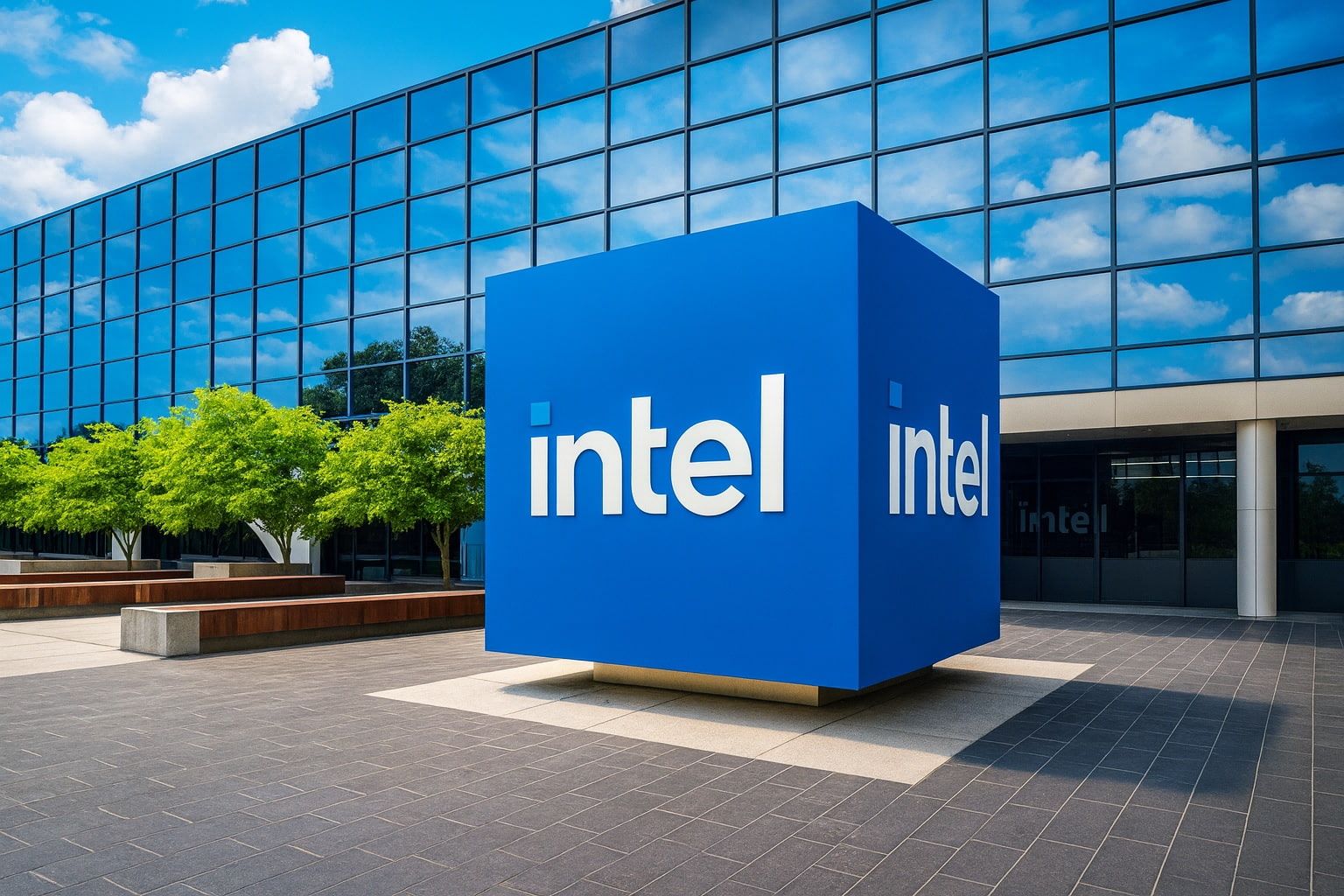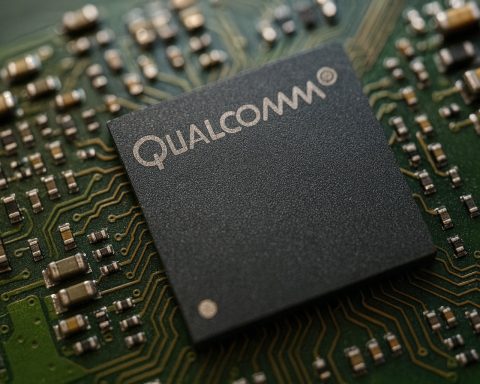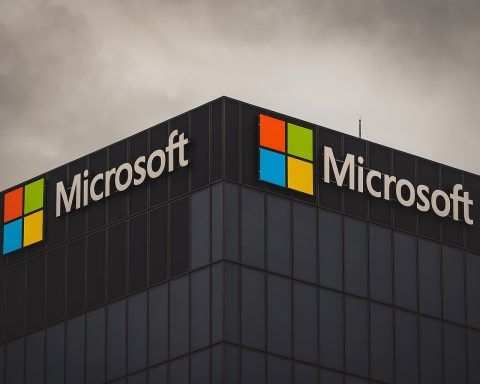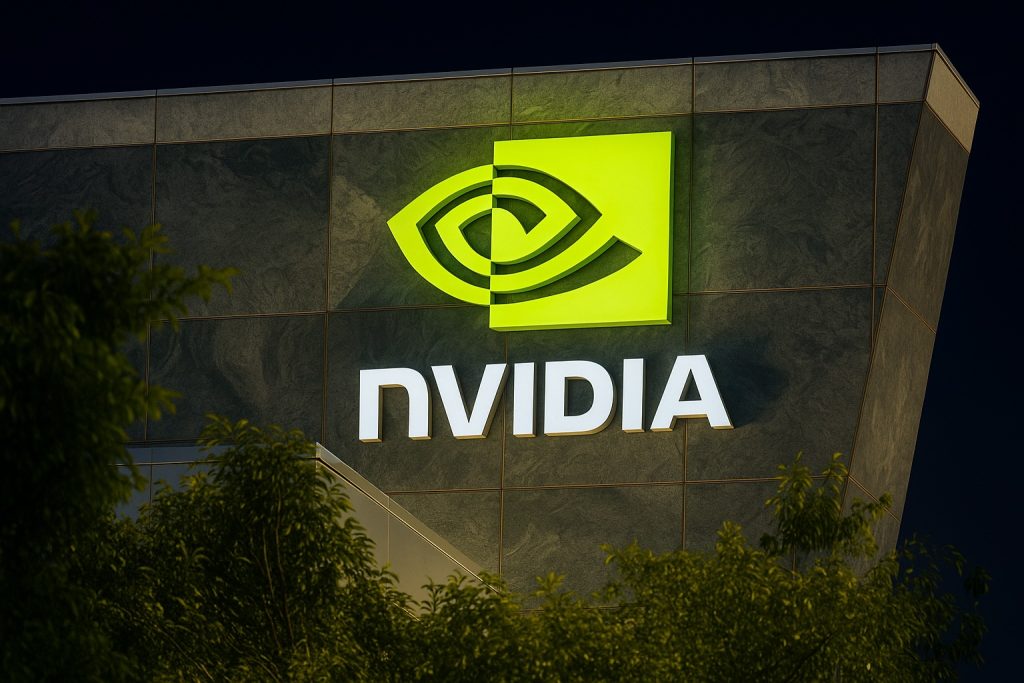- INTC soars on comeback trail: Intel’s stock (INTC) surged to an 18-month high around $39 per share after a surprise quarterly profit, extending a 2025 rally of nearly +90% – far outperforming rival chip stocks Nvidia and AMD [1] [2].
- Return to profitability: The chipmaker swung back to profit in Q3 2025, posting $0.23 adjusted EPS vs roughly $0.01 expected on $13.7 billion revenue [3]. Aggressive cost-cutting lifted gross margins to ~40% (beating ~36% consensus) [4], sparking an after-hours jump in INTC shares.
- Big backers bet on Intel: Massive external investments have fueled optimism. The U.S. government is taking a 9.9% Intel stake (~$8.9 billion) [5]; Nvidia is investing $5 billion for ~4% of Intel [6]; and Japan’s SoftBank bought $2 billion in shares [7] – unprecedented lifelines aimed at reviving Intel’s chipmaking edge.
- AI chips and new technology: Intel is pivoting to AI and cutting-edge chips. In October it unveiled “Panther Lake” PC processors built on its 18A (≈2 nm) process – with first units shipping by late 2025 [8] – and plans a new AI-focused data center GPU for 2026 [9]. These next-gen chips, made on U.S. soil, are key to Intel’s effort to regain technological leadership.
- Analysts urge caution: Despite the euphoria, Wall Street remains cautious. The average 12-month analyst target (≈$28) sits 20–30% below Intel’s current price [10], and Intel’s valuation (~71× forward earnings) far exceeds peers like Nvidia (~30×) [11]. Bernstein analysts warn the turnaround is “far from over” [12] even as a few bulls have raised targets above $40 [13].
- AI boom lifts rivals: The same AI wave buoying Intel is propelling competitors. Nvidia’s market cap has hit $1 trillion as it dominates AI chips, and AMD’s stock is up ~80% in 2025 after scoring major AI processor wins [14]. By contrast, Intel’s market value (~$175 billion) is roughly half of AMD’s and only a fraction of Nvidia’s [15] – underscoring the gap Intel still aims to close.
Shares Soar on AI Buzz and “Rescue” Deals
Intel’s stock price has rallied dramatically in 2025, recently reaching its highest level since early 2024 on the back of AI optimism and hefty strategic investments.
Intel Corporation’s stock price has been on a tear, hitting levels not seen in over a year and a half. Shares of the Silicon Valley semiconductor icon jumped as much as 7–8% after its latest earnings report, briefly reaching an 18-month high (around $39–$40) [16]. The stock is now trading near a two-year peak, marking a dramatic turnaround from its struggles in 2022–2024. Year-to-date, INTC has nearly doubled in value (up ~85–90%), outpacing even high-flying peers like artificial-intelligence leader Nvidia and longtime rival AMD [17]. Investors have piled in on hopes that Intel’s new strategy – centered on AI chips and bold partnerships – can restore the company’s former glory.
A wave of blockbuster deals underpins this optimism. In a highly unusual move, the U.S. government announced it will convert CHIPS Act subsidies into a roughly 10% equity stake in Intel (a ~$8.9 billion investment) [18]. The aim is to ensure a domestic champion for advanced chips, signaling Washington’s faith in Intel’s strategic importance [19]. Around the same time, Nvidia agreed to invest $5 billion for about 4% of Intel’s shares as part of a partnership to co-develop next-generation AI semiconductors [20]. And in August, Japan’s SoftBank quietly purchased $2 billion of Intel stock via its Vision Fund [21]. These infusions – totaling roughly $15 billion – have given Intel a much-needed financial lifeline and vote of confidence from industry heavyweights.
Market commentators have described the backing as a potential game-changer. CNBC’s Jim Cramer even praised new CEO Lip-Bu Tan (a veteran tech investor) as a “legendary semiconductor investor” whose deals brought “adult supervision” to Intel and “sparked a roughly 50% rally” in the stock [22]. Rumors of further alliances have added fuel to the fire: reports surfaced that AMD might leverage Intel’s factories for chip production and that Microsoft (Azure) and Apple could become major Intel foundry customers or investors – speculation that sent Intel shares jumping in early October [23]. “Investors are eager for any sign of Intel winning big orders” from rivals or tech giants, one analyst noted [24]. This frenetic deal-making and buzz around AI have dramatically shifted market sentiment in Intel’s favor.
Earnings Beat Signals a Turnaround
Intel’s latest financial results gave credence to the comeback narrative. For the third quarter of 2025, Intel swung back to profitability, a sharp improvement after steep losses last year. The company delivered adjusted earnings of $0.23 per share, handily beating the near-breakeven $0.01 that analysts had expected [25]. Revenue came in around $13.7 billion, slightly higher than forecasts and roughly 8% sequential growth from Q2 [26]. Perhaps most impressively, Intel’s gross profit margins rebounded to 40%, topping consensus estimates (~35–36%) [27]. The earnings beat – Intel’s first positive surprise in recent memory – sent its stock up sharply in post-market trading and into the next day’s session [28].
Executives credited CEO Lip-Bu Tan’s aggressive restructuring for the improved results. Tan, who took the helm in early 2025, has moved swiftly to cut costs and refocus the business. Intel’s CFO Dave Zinsner noted that the company’s chip demand was actually outstripping supply in the third quarter – a “high-class problem” driven by data-center operators upgrading their CPUs to support new AI workloads [29]. Thanks to deep spending cuts, including layoffs of over 20% of Intel’s workforce this year and the sale of non-core assets like a majority stake in its Altera FPGA unit, Intel’s finances have steadied [30]. “Intel has turned a corner and is steadying the ship,” said Ben Bajarin, CEO of Creative Strategies, adding that the company’s progress “feels like a strong setup for 2026” [31].
The Q3 report marks a tentative turning point after a brutal 2024, when Intel posted its first annual loss in nearly four decades [32] [33]. Tan has slashed spending and even dialed back the grand manufacturing expansion plans of his predecessor. Intel told investors that it will end 2025 with over 20% fewer employees than it started the year [34]. The belt-tightening, while painful, appears to be paying off in improved margins. “Shares popped after-hours based on better-than-feared guidance, visible cost and gross margin progress, AI-PC buzz, and $15 B of fresh strategic funding that shores the balance sheet,” observed Michael Schulman, chief investment officer at Running Point Capital [35]. Intel slightly tempered expectations for the holiday quarter – forecasting Q4 revenue of $12.8–13.8 billion (a midpoint just shy of Wall Street’s ~$13.3 billion consensus) [36] – but investors seemed relieved that the outlook held no new negative surprises.
Still, Intel’s leadership acknowledges the turnaround is far from complete. CFO Zinsner cautioned that yields on Intel’s cutting-edge 18A manufacturing process (used for upcoming 2 nm-class chips) “are not where we need them to be” and likely won’t reach industry-standard levels until 2027 [37]. In other words, Intel’s most advanced chip fabs are still ramping up and not yet running efficiently. Additionally, the company’s core PC and server CPU businesses are recovering only gradually, and Intel remains unprofitable on a trailing 12-month basis. Indeed, many analysts note Intel isn’t expected to return to full-year profitability until 2026 [38]. “We understand the desire to claim victory for the embattled company, but this fight is far from over – perhaps it’s better to call it a draw for now,” analysts at Bernstein wrote after the earnings, urging caution [39].
Wall Street Split on How Much Upside Is Left
The scale of Intel’s stock rally in 2025 has taken many experts by surprise – and left opinions sharply divided on what comes next. Year-to-date, Intel shares have skyrocketed about 90%, recovering from multiyear lows and vastly outperforming most semiconductor peers [40]. That surge reflects renewed optimism, but also means Intel’s valuation looks stretched by conventional metrics. The stock now trades around 71 times forward earnings, a lofty multiple even compared to high-growth rivals like Nvidia (~30×) or AMD (~40×) [41]. In part this is because Intel’s current earnings are depressed (making the P/E ratio high), but it also implies investors are pricing in a big turnaround that has yet to fully materialize in the numbers.
Most Wall Street analysts remain cautious. The consensus 12-month price target for Intel stock sits in the mid-$20s to low-$30s [42], below the current market price in the high-$30s. For instance, Bank of America recently downgraded Intel to “Underperform”, arguing the stock had run “too far, too fast” ahead of fundamentals [43]. Deutsche Bank likewise reiterated a Hold rating with a ~$30 target even after the Nvidia investment news, citing ongoing “execution risks” in Intel’s turnaround [44]. As a result, many firms advise caution or holding off – Visible Alpha data show the majority of analysts still rate INTC a Hold or Sell, and the average target implies ~20% downside from today’s levels [45].
At the same time, a minority of bulls are doubling down on Intel’s resurgence. A few analysts have lifted their targets into the $40+ range following the recent deals [46]. They point out that Intel’s revenue base and market share give it significant leverage if margins improve. Some bulls also argue Intel’s valuation looks reasonable relative to peers on a sales basis – about 3× forward sales, versus much higher multiples for Nvidia – if one believes earnings will rebound [47]. Notably, Intel’s stock still trades at a steep discount to its heyday: it remains far below its 2021 peak (when PC and data-center sales were booming) and below the market caps of its upstart competitors. Supporters say the combination of new strategic partners, government backing, and fresh leadership under Tan could allow Intel to surprise skeptics. “Intel has picked up invaluable allies and a cash war chest,” wrote one market commentator, “[the market] gave Intel a major pass on their current struggles in anticipation of positive news… but future gains will need to be earned by improved results” [48].
The mixed sentiment is evident in recent trading. Intel’s stock has seen bouts of profit-taking whenever it inches near the $40–$42 technical resistance zone that some chart-watchers flag [49]. Short interest in the stock remains elevated, reflecting bets that Intel’s rally will pull back [50]. Yet dip-buyers have consistently stepped in on any weakness – for example, when INTC shares briefly slid ~10% from their early-October high, bargain hunters bought around the mid-$30s, quickly stabilizing the price [51] [52]. This tug-of-war suggests the stock could be range-bound until Intel delivers more concrete evidence of a sustainable turnaround. In the near term, volatility may stay high: options markets were pricing in large swings around earnings, and an outsized move (up or down) could still occur as investors digest Intel’s trajectory [53]. As Bernstein’s team put it, claiming victory now might be premature – 2026 will be the true test of whether Intel can translate its bold bets into lasting shareholder value.
Intel Lags in the AI Race Against Nvidia and AMD
The backdrop for Intel’s resurgence is a fierce “AI arms race” in the semiconductor industry – one that Intel is fighting from behind. While Intel has dominated PC processors for decades, it missed out on the first wave of the AI boom, ceding the spotlight (and market capitalization) to competitors that seized the initiative in graphics processors and specialized AI chips. Nvidia, in particular, has become the poster child of AI computing: it now commands roughly 90% of the data-center AI accelerator market, thanks to its powerhouse GPUs that are the workhorses of machine learning [54]. Nvidia’s stock has more than doubled since early 2024, and the company recently joined the exclusive $1 trillion market cap club [55]. By comparison, Intel’s market value – about $175 billion – is tiny next to Nvidia’s, highlighting how much investor perception has shifted in favor of AI-centric chipmakers [56].
AMD has also ridden the AI wave to new heights. Long Intel’s chief rival in PC and server CPUs, AMD has expanded into adaptive AI and data-center GPUs, and it scored major wins this year by supplying custom AI chips to firms like OpenAI and Oracle. In mid-October, AMD’s stock hit an all-time high near $240 (up ~80% year-to-date) after announcing new AI chip deals [57]. AMD’s market capitalization (around $350 billion) now eclipses Intel’s by a wide margin [58] – a remarkable reversal of fortunes, given that Intel was worth far more than AMD for most of their history. Some bullish analysts even predict AMD could reach $300 per share if its AI momentum continues [59]. “Intel is scrambling to keep up,” noted one industry observer, as the old guard Intel finds itself looking up at faster-moving rivals in high-growth segments [60].
Beyond GPUs, the competitive landscape includes foundry leaders like TSMC (Taiwan Semiconductor Manufacturing Co.) and Samsung, which dominate contract chip fabrication. Intel’s prior CEO had aimed to turn Intel into a cutting-edge foundry for other companies’ chips (to rival TSMC), but heavy spending and delays plagued that vision [61]. Under Tan, Intel has pared back those ambitions – now vowing to build new factories only when there are confirmed big customers [62]. So far, Intel’s foundry unit has landed only small deals (for example, making some chips for Taiwan’s MediaTek) and is still seeking a marquee customer to showcase its manufacturing prowess [63]. Rumors of a cloud giant like Microsoft outsourcing chip production to Intel – or AMD using Intel’s fabs – have tantalized investors, but no such deal has been officially struck yet [64].
Intel also faces pressure in its core markets. In PCs and servers, AMD’s Ryzen and Epyc processors have steadily eaten into Intel’s share, grabbing an estimated ~30% of the desktop CPU market and significant portions of the server market [65] [66]. Meanwhile, new entrants using ARM-based chips (like Apple’s M-series for Macs and Amazon’s Graviton for servers) are bypassing Intel architecture in some segments. And in mobile devices, Intel ceded that arena to companies like Qualcomm years ago; Qualcomm is now eyeing the data-center AI chip space too, though it remains in early stages [67]. In short, Intel is fighting on multiple fronts – trying to defend its x86 CPU stronghold while also playing catch-up in the booming AI processor arena.
Critics argue that no amount of investment can quickly fix Intel’s technology gap. “Intel’s problems are beyond a cash infusion… [it] needs to catch up with TSMC technologically to attract business,” warned one portfolio manager, questioning whether Intel can truly leapfrog in manufacturing just with more funding [68]. Indeed, Intel’s cutting-edge “18A” process (roughly equivalent to TSMC’s upcoming 2 nm node) has reportedly encountered yield issues that threaten to delay its rollout [69] [70]. Intel acknowledged in its earnings call that 18A yields won’t reach “industry-acceptable” levels until 2027 [71], effectively conceding that TSMC will likely remain ahead on the silicon roadmap for the next couple of years. This is one reason many analysts remain skeptical: despite Intel’s bold moves, Nvidia and AMD currently enjoy stronger product line-ups in AI, and contract foundry leaders still have an edge in manufacturing tech. To truly close the gap, Intel will need to execute almost flawlessly on its new chip designs and fab projects – a tall order given its recent stumbles.
Still, Intel’s supporters counter that the company now has critical ingredients it lacked before: leadership committed to tough choices, deep-pocketed partners, and government backing. National security concerns are also reshaping the industry’s playing field. The U.S. government’s willingness to financially prop up Intel (and restrict China’s access to advanced chips) could tilt certain deals Intel’s way in the future [72] [73]. For example, American cloud providers and defense firms might be encouraged – formally or informally – to use Intel’s domestically made chips for sensitive applications. Such support, combined with Intel’s existing scale, mean the company can’t be counted out. As CEO Lip-Bu Tan likes to frame it, Intel is on a “second chance” to catch the AI wave and reestablish itself as a leader.
Betting on New Chips and an “AI-First” Future
To seize that second chance, Intel is racing to deliver on an ambitious technology roadmap. A cornerstone of its strategy is the upcoming “Panther Lake” processor – Intel’s first PC/laptop chip built on the all-new 18A manufacturing process. Aimed at high-end, AI-powered notebooks, Panther Lake will begin high-volume production by the end of 2025, with the first units shipping to customers before the year is out [74]. This chip is a make-or-break test of Intel’s ability to deploy 18A, which introduces advanced transistor designs and power delivery methods. Intel claims Panther Lake’s integrated CPU+GPU will offer 50% faster performance than its current generation (many of which were actually made by TSMC) [75]. “Panther Lake is extremely important to Intel on many different levels,” said Technalysis Research chief analyst Bob O’Donnell, because it will demonstrate whether Intel’s factories can once again produce world-class chips at the leading edge [76]. In other words, it’s not just a new product – it’s a proving ground for Intel’s manufacturing turnaround.
Lip-Bu Tan has also emphasized an “AI-first” focus for Intel’s product lineup. On the data-center side, Intel is readying a new server CPU family code-named Clearwater Forest, set to launch in the first half of 2026 [77]. These will be built on the same 18A process at Intel’s updated Arizona fabs (known as Fab 52, now fully operational) [78], and they are touted to be far more power-efficient – a key selling point for AI data centers. While Intel has struggled in the discrete AI accelerator market, the hope is that pairing its CPUs with acceleration features (and co-developing hybrid chips with partners like Nvidia) will help it reclaim some share in AI infrastructure. In fact, Intel plans to roll out a new AI-focused graphics processing unit (GPU) in 2026 aimed at cloud data centers [79]. This would pit Intel against Nvidia’s GPUs directly, though details are scarce so far. Tan remains optimistic, saying these new technologies “are catalysts for innovation across our business as we build a new Intel” [80].
To support its roadmap, Intel is making huge capital investments – albeit more targeted ones than before. The company expects to spend about $27 billion on capital expenditures in 2025, up from $17 billion in 2024 [81], as it outfits its fabs for 18A and beyond. Notably, Intel has even halted development of its next-next-gen 14A process (which would succeed 18A) until it lines up a committed customer for it [82]. This more disciplined approach is meant to avoid the costly overbuilding that hurt Intel previously. Instead, Intel is leveraging outside funding to share the load – for example, the $8–9 billion from the U.S. government will effectively subsidize its Arizona fabs, and Nvidia’s $5 billion stake comes with plans to jointly design chips that use Intel manufacturing [83] [84]. Such partnerships could bring in guaranteed volume for Intel’s foundry business if executed well.
Looking ahead, analysts say Intel’s execution in the next 12–18 months will be critical. The company has to convince both investors and customers that its bold bets are yielding real technological gains. Early indicators – like meeting the Panther Lake launch schedule, achieving decent yields on 18A, and securing at least one big foundry client – will be closely watched. Meanwhile, external factors like the global economy and tech spending cycles will play a role. On the positive side, demand for chips tied to AI and cloud computing is surging: industry forecasts predict global semiconductor sales will hit a record ~$697 billion in 2025, largely driven by data-center and AI hardware needs [85]. Major cloud players and internet firms are pouring unprecedented capital into AI infrastructure, fueling what some call a “supercycle” in chip spending [86]. This tide could lift all boats, including Intel, especially as PC sales also stabilize (PC demand is expected to grow modestly ~4% in 2025 after two down years) [87].
However, macro and geopolitical challenges lurk. U.S.-China tensions and export controls on advanced chips mean Intel must navigate a tricky international landscape. Its new government shareholder could complicate relations in markets like China if foreign customers perceive Intel as an arm of U.S. industrial policy [88]. Intel itself warned that having the U.S. as an owner might subject it to foreign regulatory hurdles [89]. On balance, though, the political tailwinds from Washington’s focus on domestic chip capacity are a unique advantage for Intel – access to funding and contracts that others might not get [90].
After years of setbacks, Intel now has a rare opportunity to stage a comeback. The company’s stock has already rebounded dramatically on hope and hype. The next chapter will be about execution – delivering the promised chips, hitting tech milestones, and regaining customer trust. If Intel can follow through, it may not only sustain its stock rally but also reassert itself as a leader in the semiconductor industry’s new AI-driven era. As 2026 approaches, all eyes will be on whether Intel’s bet on itself pays off in a lasting way. The stakes – for Intel, its investors, and even U.S. tech leadership – could not be higher.
Sources: Recent reporting from Reuters, TechStock² (ts2.tech), and other financial outlets was used in this report [91] [92] [93] [94] [95] [96], along with Intel’s official disclosures and industry analyses.
References
1. www.reuters.com, 2. www.reuters.com, 3. ts2.tech, 4. www.reuters.com, 5. ts2.tech, 6. ts2.tech, 7. ts2.tech, 8. www.reuters.com, 9. ts2.tech, 10. ts2.tech, 11. www.reuters.com, 12. www.reuters.com, 13. ts2.tech, 14. ts2.tech, 15. ts2.tech, 16. www.reuters.com, 17. www.reuters.com, 18. ts2.tech, 19. ts2.tech, 20. ts2.tech, 21. ts2.tech, 22. ts2.tech, 23. ts2.tech, 24. ts2.tech, 25. ts2.tech, 26. ts2.tech, 27. www.reuters.com, 28. www.reuters.com, 29. www.reuters.com, 30. www.reuters.com, 31. www.reuters.com, 32. www.reuters.com, 33. ts2.tech, 34. www.reuters.com, 35. www.reuters.com, 36. www.reuters.com, 37. www.reuters.com, 38. ts2.tech, 39. www.reuters.com, 40. www.reuters.com, 41. www.reuters.com, 42. ts2.tech, 43. ts2.tech, 44. ts2.tech, 45. ts2.tech, 46. ts2.tech, 47. ts2.tech, 48. ts2.tech, 49. ts2.tech, 50. ts2.tech, 51. ts2.tech, 52. ts2.tech, 53. ts2.tech, 54. ts2.tech, 55. ts2.tech, 56. ts2.tech, 57. ts2.tech, 58. ts2.tech, 59. ts2.tech, 60. ts2.tech, 61. www.reuters.com, 62. ts2.tech, 63. ts2.tech, 64. ts2.tech, 65. ts2.tech, 66. ts2.tech, 67. ts2.tech, 68. ts2.tech, 69. www.reuters.com, 70. ts2.tech, 71. www.reuters.com, 72. ts2.tech, 73. ts2.tech, 74. www.reuters.com, 75. www.reuters.com, 76. www.reuters.com, 77. www.reuters.com, 78. www.reuters.com, 79. ts2.tech, 80. www.reuters.com, 81. www.reuters.com, 82. www.reuters.com, 83. www.reuters.com, 84. www.reuters.com, 85. ts2.tech, 86. ts2.tech, 87. ts2.tech, 88. ts2.tech, 89. ts2.tech, 90. ts2.tech, 91. www.reuters.com, 92. www.reuters.com, 93. www.reuters.com, 94. ts2.tech, 95. www.reuters.com, 96. www.reuters.com





